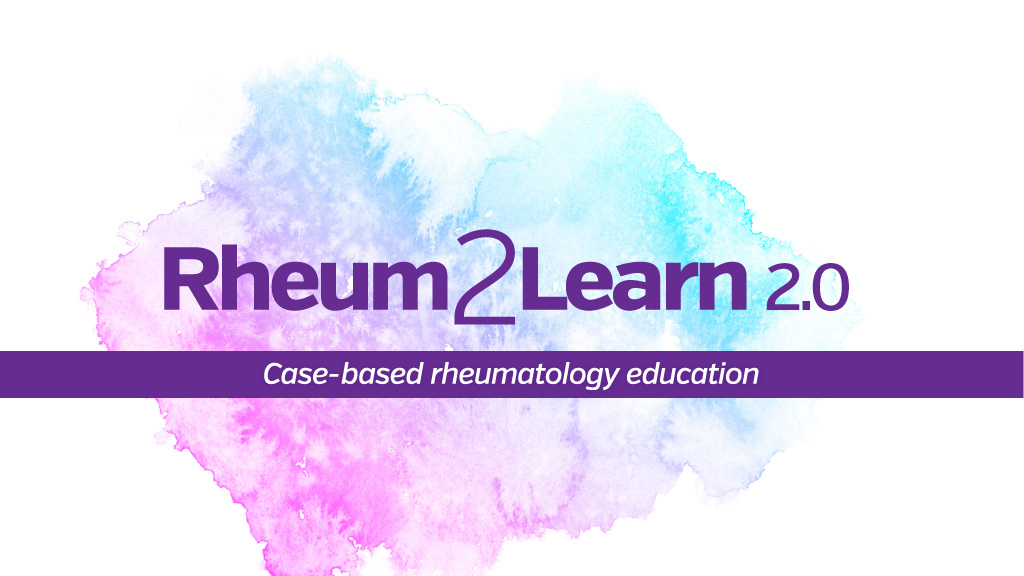
Rheum2Learn 2.0: Pediatric Rheumatology
Activity Overview
Rheum2Learn 2.0 is case-based fundamental clinical rheumatology education for residents. Each interactive activity includes three patient cases that focus on the care and assessment of individuals with rheumatologic diseases.
In this activity, learn how to examine, diagnose, and implement a pediatric patient-centered approach for three children with rheumatic conditions. The conditions included are juvenile idiopathic arthritis (JIA), juvenile dermatomyositis (JDM), and Kawasaki disease (KD).
Rheum2Learn Series
This activity is part of a series. See all activities in the series below.
- Rheum2Learn 2.0: Crystalline Arthritis
- Rheum2Learn 2.0: Infectious Arthritis
- Rheum2Learn 2.0: Inflammatory Myopathies
- Rheum2Learn 2.0: Musculoskeletal Disorders
- Rheum2Learn 2.0: Musculoskeletal Examination
- Rheum2Learn 2.0: Osteoporosis
- Rheum2Learn 2.0: Osteoarthritis
- Rheum2Learn 2.0: Pediatric Rheumatology
- Rheum2Learn 2.0: Rheumatic Manifestations of Systemic Disease
- Rheum2Learn 2.0: Rheumatoid Arthritis
- Rheum2Learn 2.0: Spondyloarthritis
- Rheum2Learn 2.0: Sjögren’s Disease
- Rheum2Learn 2.0: Systemic Lupus Erythematosus
- Rheum2Learn 2.0: Systemic Sclerosis
- Rheum2Learn 2.0: Systemic Vasculitis
Registration is complimentary.
Target Audience
Residents in training who may provide care for pediatric patients with rheumatic diagnoses in primary care, inpatient, critical care, and other clinical contexts.
The activity may also be of interest to medical students, fellows in training, advanced practice providers, practicing physicians, and other health care professionals who seek to strengthen their clinical knowledge of rheumatic diseases.
Learning Objectives
Upon completion of this activity, participants should be able to:
- Formulate a differential diagnosis for a child with joint pain
- Explain the role of laboratory tests in diagnosing and managing juvenile idiopathic arthritis (JIA)
- Recognize the major distinguishing features of the 7 types of JIA
- Indicate the complications associated with JIA
- Outline general management strategies for JIA
- Identify common cutaneous findings associated with juvenile dermatomyositis (JDM)
- Describe physical exam maneuvers used to assess for weakness in a child with suspected myositis
- Compare and contrast features of inflammatory and non-inflammatory myopathies
- Recognize the common and potentially life-threatening complications associated with JDM
- Outline treatment strategies for children with JDM
- Outline the clinical features and diagnostic criteria for Kawasaki Disease (KD)
- Formulate a differential diagnosis for a child with suspected KD
- Describe risk factors for the major complications of KD
- Propose a treatment regimen for children with suspected KD
CE & MOC Information
This activity is not eligible for CME/MOC.
Acknowledgement of Commercial Support
The project was supported by grant number 1 NU58DP006908-01-00 – Component A: Developing and Disseminating Programs to Build Sustainable Lupus Awareness, Knowledge, Skills and Partnerships. Its contents are solely the responsibility of the authors and do not necessarily represent the official views of the Department of Health and Human Services, Centers for Disease Control and Prevention.
Educational Activity Policies
See ACR educational activity policies, including the online enduring activity refund policy.